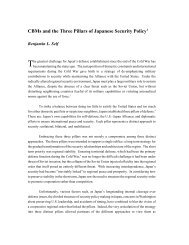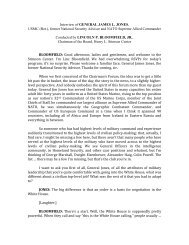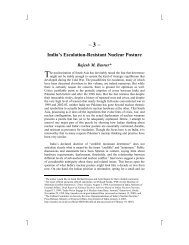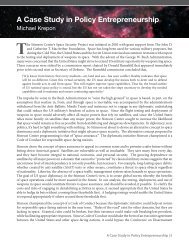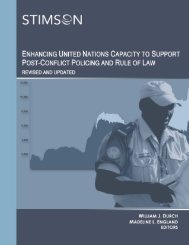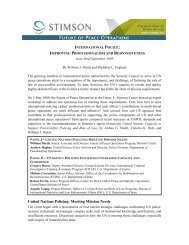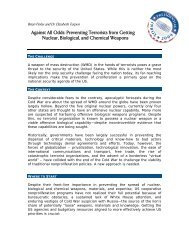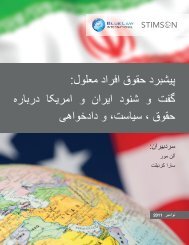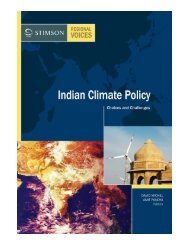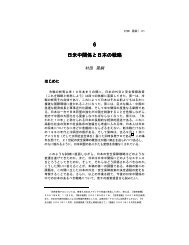Islam and Politics - The Stimson Center
Islam and Politics - The Stimson Center
Islam and Politics - The Stimson Center
Create successful ePaper yourself
Turn your PDF publications into a flip-book with our unique Google optimized e-Paper software.
38 | Role of Religion in Afghan <strong>Politics</strong>: Evolution <strong>and</strong> Key Trends<br />
groups of students—the religious <strong>and</strong> the secular—hold clashing views on the direction<br />
<strong>and</strong> progress of the country. With its international supporters investing in <strong>and</strong> encouraging<br />
secular education, the government is unable to prevent the marginalization of <strong>Islam</strong>ic education.<br />
This could widen the rift between the religiously educated <strong>and</strong> the government.<br />
Given the number of international actors shaping the forces of Afghanistan’s development<br />
<strong>and</strong> democratic governance, it is not surprising that secular education has gained significant<br />
ground in recent years. Over 5 million children have attended school since 2002, <strong>and</strong><br />
large segments of the population underst<strong>and</strong> the proven link between education <strong>and</strong> higher<br />
st<strong>and</strong>ards of living. Secular educational resources <strong>and</strong> schools are available to the youth in<br />
urban areas, <strong>and</strong> they are eager to pursue these opportunities.<br />
In the villages, however, the youth generally go for religious education because secular<br />
schools are unavailable, <strong>and</strong> because the endemic security challenges encourage people to<br />
seek refuge in tradition. This widens the gap between city <strong>and</strong> rural populations. Increasing<br />
emphasis on secular education <strong>and</strong> educators at the cost of neglecting the religious scholars<br />
has also bred discontent among the mullahs. A significant number cite their frustration<br />
with the government for not consulting them, or ignoring their advice when they do consult<br />
them.<br />
Madrassas<br />
Religious schools, or madrassas, which were present in Afghanistan since the early years<br />
of <strong>Islam</strong>’s presence there, evolved under different rulers <strong>and</strong> in different environments<br />
throughout the 20th century. While traditionally seen as an indispensable part of Afghan<br />
society, religious education in Afghanistan has sometimes faced hostility or indifference<br />
from other countries. <strong>The</strong> people of Afghanistan consider these institutions <strong>and</strong> religious<br />
scholars to be an integral part of their history <strong>and</strong> identity, but the West generally views<br />
madrassas as a breeding ground for extremism.<br />
<strong>The</strong>re is little support in foreign governments for investing in religious education because<br />
of limited underst<strong>and</strong>ing of Afghanistan, <strong>and</strong> the perception of links between madrassas<br />
<strong>and</strong> extremism. <strong>The</strong>re is also concern that international involvement in building madrassas<br />
would fuel popular perceptions in Afghanistan that non-Muslims are trying to meddle with<br />
the <strong>Islam</strong>ic faith. Negative attitudes already exist toward Muslim countries that are actively<br />
funding Afghan madrassas <strong>and</strong> influencing the curriculum, such as Egypt, Iran, Kuwait,<br />
<strong>and</strong> Saudi Arabia. <strong>The</strong> Karzai administration has few nondonor resources of its own to<br />
invest, <strong>and</strong> is wary of madrassas that are funded from Iran <strong>and</strong> Pakistan. Afghans studying<br />
in madrassas abroad, <strong>and</strong> allegedly being indoctrinated by extremist ideologies, are<br />
also a cause of concern. Iran has been investing heavily in curriculum development in the<br />
schools in western Afghanistan, especially in the provinces on the border between Iran <strong>and</strong>



